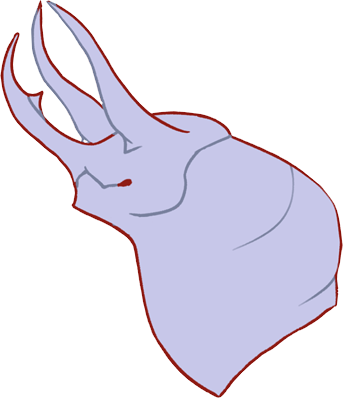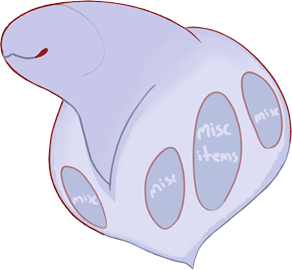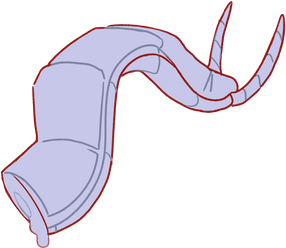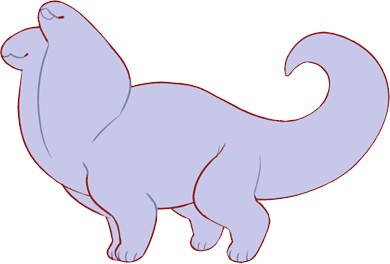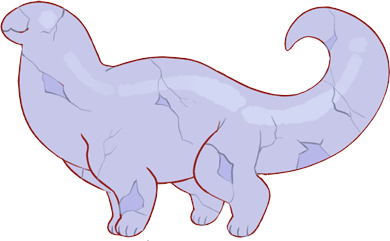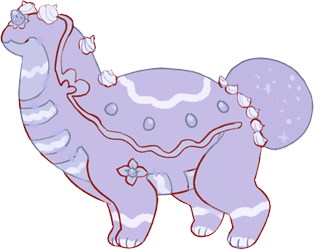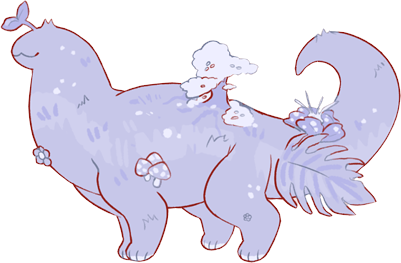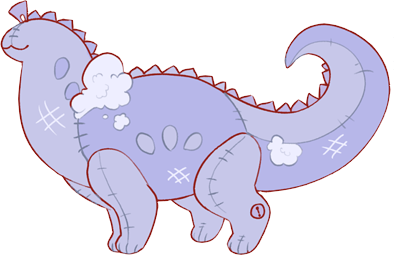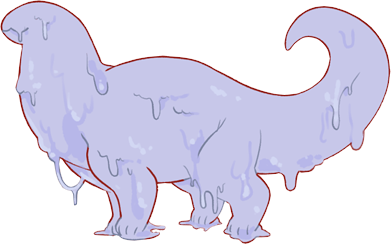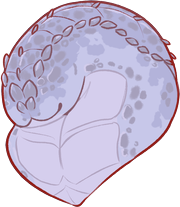Traits
Beetle head horns (Uncommon Myth)
Sporting large extravagant horns, the leech's head and neck can also be covered in hard plates.
This trait is varied and can mimic a variety of horned beetles.
Folks of old used to make legendary armor from beetle headed leeches.
Ceratops horns (Uncommon Myth)
A combination type consisting of a large platelike horn crest, often accompanied by smaller horns on the front of the head.
The plate can have an array of markings and patterns on it. Leeches with this trait are incredibly mesmerizing to look at.
Container neck (Uncommon Myth)
Sometimes pores in a leech's neck will develop a transparent skin over them, expanding and fleshing out into pockets for storage.
Leeches featuring this trait will use them to show and display things that they're fond of collecting, whether it be physical objects, blood, or other foods. They tend to have much bulkier necks as well, both to have space for the neck cavities and strength to hold things stored inside.
It's extremely popular with luxuries and pets to have this combined with blush cheeks.
Frill neck (Uncommon Myth)
A rare mutation in which a leech sports a large frill of skin around its neck.
In the wild leeches use this frill to intimidate attackers, but they can also use it to express their emotions. A frill neck can just be plainly colored, but they often sport eye-like designs to add to the intimidation effect.
Note: The frill can usually be raised and lowered at will, but can permanently be either or; and positioned anywhere on the neck itself.
Container tail (Uncommon Myth)
A huge membranous tail filled with liquid. The top of the tail always presents thicker patches of skin or opaque patterns.
The liquid color varies, for example: It may be blood that's stored for future consumption, or a sweet smelling liquid the leech utilizes to attract prey.
It's shown to be connected to the digestive tract, so any liquid stored inside must be ingested by the leech first, and processed or stored directly.
Centi tail (Uncommon Myth)
A strong wide tail covered in segmented patches of thicker skin.
The grippers at the end can't move on their own and they are actually sensory organs. Leeches with this trait are incredibly spatially aware and cannot be snuck up on easily.
It's very common to see paired with grabber claws, resulting in a leech curling this tail up and shielding prey or a favored toy to protect it from theft.
Ray tail (Uncommon Myth)
A complex tail with an array of stingray-like fins. The tip of it can come equipped with a vicious detachable barb to strike prey.
While this tail is long and slender, it still cannot exceed a leech's body length unless it is Saltwater class.
Leeches with this trait are often targeted by poachers, but are swift and maneuverable swimmers.
Extra head (Uncommon Myth)
A mutation in which a leech grows a second head.
The extra head may share the same consciousness as the original but it may just as well develop its own personality. They still retain a basic level of intelligence, however; two brains don't result in much thinking beyond a double craving for food!
Note: This allows for one extra head per upgrade, but multiple upgrades can be made for more heads.
Solid body (Uncommon Myth)
An unusual mutation that calcified much of the leech's body to resemble stone.
The body is hard like a rock; it cracks over time from the leech’s movement and is frequently infused with metals, rocks, or other inorganic materials from the environment. They have a hard time moving fast, but will get there in the end!
These leeches can endure dry environments, but any deep wounds won’t heal well and it might just crumble apart - often the leech's internal organs become a series of very fine tubes and veins throughout the body much like a tree, so that if permanent bodily damage happens it will not result in immediate death.
Note: Body types cannot be partially applied or mixed outside of an official or legendary capacity. A leech can only have ONE type of body mutation. These are any traits in the trait list with the name 'body' in the title, e.g Fur body, Solid body, Feathered body, etc. OR their official partial variant.
Food body (Uncommon Myth)
A mimic-type mutation that caused the leech's body to resemble delicious human food.
Hugely popular among pet leeches, this is also oddly enough seen in wild-types who seem to prefer preying on people.
While it looks like food, the leech's body is still made of skin and flesh, and any nonsolid shapes such as cream or sauce is usually a secretion of slime, or blood byproducts such as plasma. Ordinary leech flesh is already unpalatable, but a food body leech is as disgusting as they can get.
Note: Body types cannot be partially applied or mixed outside of an official or legendary capacity. A leech can only have ONE type of body mutation. These are any traits in the trait list with the name 'body' in the title, e.g Fur body, Solid body, Feathered body, etc. OR their official partial variant.
Glass body (Uncommon Myth)
A variation of transparent body, only the organs have been combined with the skin in an osmotic capacity, leaving a completely hollow shell that resembles glass or plastic.
Some leeches have pigments in their glasslike skin resulting in solid colored patches, such as the face or limbs, but the body underneath is still hollow.
They have a tendency to hoard items such as sand, candy, jewels or even liquids within their body as a protective measure, but this can result in them getting shattered by people who want to get at the treasure inside. Owners of these leeches tend to be rich enough to have very strong home security to prevent such breakages, and show them off with valuables inside as a display of wealth.
Note: Body types cannot be partially applied or mixed outside of an official or legendary capacity. A leech can only have ONE type of body mutation. These are any traits in the trait list with the name 'body' in the title, e.g Fur body, Solid body, Feathered body, etc. OR their official partial variant.
Garden body (Uncommon Myth)
The body is much denser and nutrient-rich, allowing the growth of plants.
While not all of the leech must be covered in or replaced by leaves and flowers, the trait refers to the potential rather than what can be seen. An unmaintained plant body leech may eventually become a miniature walking jungle, but most like to selectively groom themselves.
These leeches maintain a symbiotic and often codependent relationship with the plants that grow on them; the leech provides nutrients, while the plants keep the leech alive beyond its years. That being said, a garden leech is only as healthy as the plants on its back.
Many owners like to cultivate and maintain a single plant type on their leech, and particularly traditional enthusiasts like to introduce bonsai trees as a symbol of longevity.
Note: Body types cannot be partially applied or mixed outside of an official or legendary capacity. A leech can only have ONE type of body mutation. These are any traits in the trait list with the name 'body' in the title, e.g Fur body, Solid body, Feathered body, etc. OR their official partial variant.
Plush body (Uncommon Myth)
The body is soft and looks like it's made of various arts and crafts materials, with the insides being made of cotton.
Leeches with these traits won’t bleed out even from deep wounds, and can stitch themselves back together.
These leeches' needs are completely opposite from the norm when it comes to moisture: the drier the better. Too much exposure to damp will actually make them sick. They're highly popular as pets for homes with children.
Note: Body types cannot be partially applied or mixed outside of an official or legendary capacity. A leech can only have ONE type of body mutation. These are any traits in the trait list with the name 'body' in the title, e.g Fur body, Solid body, Feathered body, etc. OR their official partial variant.
Slime body (Uncommon Myth)
The body consists of thick slime which drips and melts off as the leech moves.
Leeches with this trait are able to digest pretty much anything simply by enveloping it and they can almost entirely melt into a puddle, and can reform as long as their organs remain intact inside. With all that being said however, they dissolve in deep water.
Note: Body types cannot be partially applied or mixed outside of an official or legendary capacity. A leech can only have ONE type of body mutation. These are any traits in the trait list with the name 'body' in the title, e.g Fur body, Solid body, Feathered body, etc. OR their official partial variant.
Floating object (Uncommon Myth)
A mythical trait controlled more often than not by a leech's developing psychic abilities or natural magnetism.
It's never hard to pinpoint a leech with floating objects, as they will have something levitating close to their body! These objects vary from leech to leech and may be something the leech values, a man made accessory, or even things like appendages and eyeballs.
Whether or not the object can be pulled from the leech's grasp is entirely up to the leech, but it's a better idea to let them be, just in case there are other more dangerous psychic abilities that the creature is hiding.
Note: This allows for one object per upgrade, but multiple upgrades can be made for more objects.
Floating appendages will require an extra limb upgrade.
Floating eyes are non-functional.
Keeled Scales (Uncommon Myth)
Keratinous protrusions on the skin.
These can vary from tiny fishlike scales and clawlike shapes, to rough chunks or armor plate. They can cover any amount of the leech's body.
